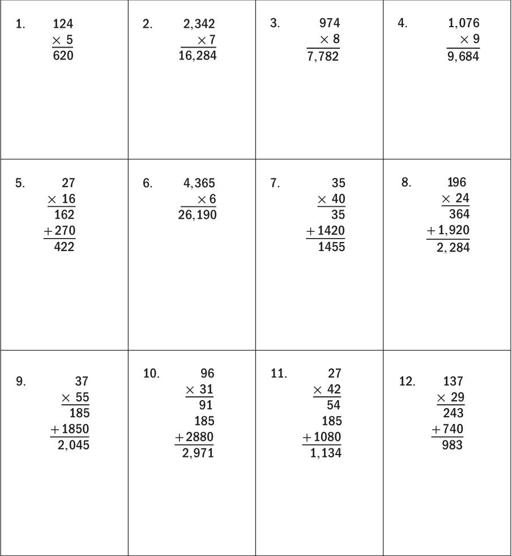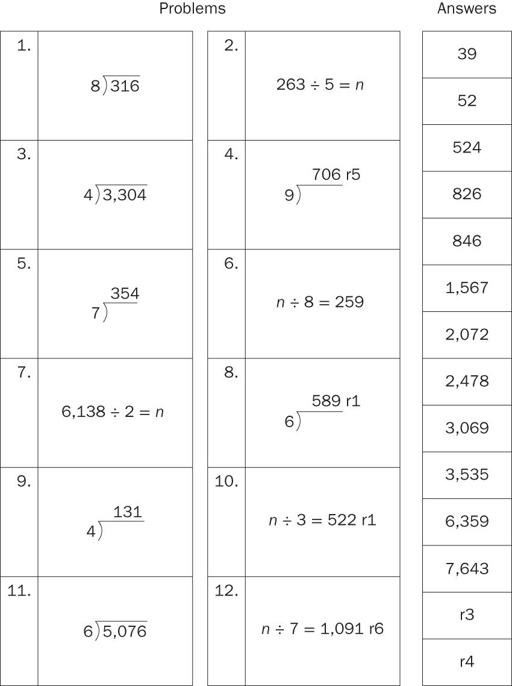Read Teaching the Common Core Math Standards With Hands-On Activities, Grades 3-5 Online
Authors: Judith A. Muschla,Gary Robert Muschla,Erin Muschla-Berry
Tags: #Education, #Teaching Methods & Materials, #Mathematics, #General
Teaching the Common Core Math Standards With Hands-On Activities, Grades 3-5 (29 page)

2.
Explain that students are to find the product of each problem. Remind them to double-check their work to make certain that their answers are correct before they begin work illustrating the process of multiplication.
3.
Explain that they are to show the steps they used to find the products on their drawing paper. They should provide detailed steps, with examples that highlight place value and use equations, similar to the example provided in the Background.
4.
Suggest to your students that they discuss possible designs and methods before beginning. They might do a “rough” draft of their ideas on a sheet of paper.
5.
Encourage your students to be creative but accurate.
Closure
Discuss students' work and allow groups to show their work to other groups. Display students' work.
Name ____________________________________ Date
_____________
Finding Errors
Directions: Some of the problems below have errors. Find the mistakes and correct them. Then choose one of the problems you corrected. Write an explanation of how to find the product using place value.
Number and Operations in Base Ten: 4.NBT.6
“Use place value understanding and properties of operations to perform multi-digit arithmetic.”
6. “Find whole-number quotients and remainders with up to four-digit dividends and one-digit divisors, using strategies based on place value, the properties of operations, and/or the relationship between multiplication and division. Illustrate and explain the calculation by using equations, rectangular arrays, and/or area models.”
Background
In division, the number you are dividing by is the
divisor
, the number you are dividing is the
dividend
, and the answer is the
quotient
. Students should be familiar with these terms. Because multiplication and division are inverse operations, students can easily check the quotient of a division problem by multiplying the quotient by the divisor and adding any remainder.
Activity 1: Demonstrating Division
Working in pairs or groups of three, students will demonstrate their understanding of division by creating a word problem that can be solved by dividing a multi-digit number by a one-digit number. They will exchange problems with another group, and then write an equation and create a rectangular array to represent the problem. Finally, they will solve the problem by using the division algorithm.
Materials
Graph paper for students; overhead projector; markers; transparency with a grid that contains at least 120 squares for the teacher.
Procedure
1.
Explain that division is the process of breaking up a number of items to find how many equal groups can be made, or how many items are in each group. Be sure that students understand the terms divisor, dividend, and quotient.
2.
Provide this example: Deanna is counting the days until her family's vacation. Her family will leave in 120 days. How many weeks is this? Ask students what this question asks them to find. (They are finding the number of groups in terms of “weeks.” There are seven days in each week.)
3.
Represent the problem with an equation:
4.
Model this on the transparency and overhead projector. Mark off 120 squares and divide them into groups with 7 in each group. (There are 17 groups of 7, with 1 square left over.)
5.
Divide 120 by 7, using the division algorithm. The quotient is 17 remainder 1, which means her family will leave in 17 weeks and 1 day.
6.
Instruct your students to create a word problem of their own that can be solved by dividing a multi-digit number by a one-digit number. Suggest that students limit the dividends in their problems to less than 200; otherwise they might have an unwieldy number of groups on their arrays. Check that students' problems are reasonable.
7.
Instruct your students to exchange their problem for the problem of another group. They are to write an equation that represents the problem, draw an array on graph paper, and then solve the problem using long division, as in the example you provided.
Closure
Have students return the problems, and confirm that the quotients, equations, and arrays are correct.
Activity 2: Division Puzzles
Working in pairs or groups of three, students will find missing quotients or missing dividends.
Materials
Reproducible, “Dividends and Quotients,” for each pair or group of students.
Procedure
1.
Distribute copies of the reproducible and explain that it contains 12 problems, each with a missing number. Along the right-hand side are 14 answers that can be dividends, quotients, and remainders.
2.
Explain that students are to complete the problems by finding the missing numbers. They are to choose their answers from the numbers on the right-hand side of the page. Note that for two problems, students must find both quotients and remainders.
3.
Explain that after students have correctly matched quotients and dividends with problems, they should write the answer in the proper place in each problem.
Closure
Review the correct answers. Discuss the strategies students used to match answers with problems.
Answers
(1)
39 r4
(2)
52 r3
(3)
826
(4)
6,359
(5)
2,478
(6)
2,072
(7)
3,069
(8)
3,535
(9)
524
(10)
1,567
(11)
846
(12)
7,643
Dividends and Quotients
Number and Operations—Fractions: 4.NF.1
“Extend understanding of fraction equivalence and ordering.”
1. “Explain why a fractionis equivalent to a fraction
by using visual fraction models, with attention to how the number and size of the parts differ even though the two fractions themselves are the same size. Use this principle to recognize and generate equivalent fractions.”
Background
Equivalent fractions are fractions that name the same number or amount. Every fraction is equivalent to fractions that can be generated by multiplying or dividing the numerator and denominator by the same non-zero number. Following are two examples:



